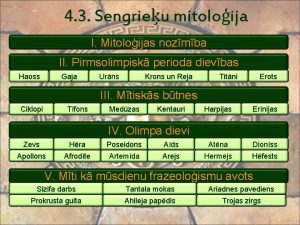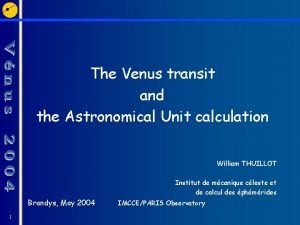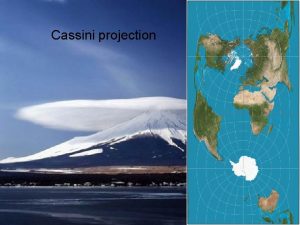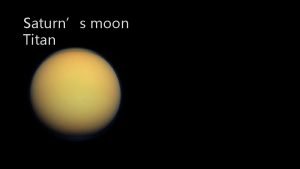Propeller Moonlets in Saturns Rings Cassini images reveal




- Slides: 4

Propeller Moonlets in Saturn’s Rings • Cassini images reveal thousands of propeller shaped structures in Saturn’s rings, some of which stretch for thousands of miles ~2 km • Scientists believe the structures are caused by small, unseen moonlets gravitationally nudging nearby smaller ring particles • The moonlets may be a ‘missing link’ that demonstrate that Saturn’s ring particles are continuously replenished Discoveries in Planetary Science Cassini image of Saturn’s rings, with arrow pointing to the location of a propeller shaped disturbance (shown in the inset). Large propeller structures observed multiple times over the past several years have been named after famous aviators. http: //dps. aas. org/education/dpsdisc/

Rings Caught Replenishing Themselves embedded propeller moonlet (~1 km) Saturn dark gap in ring cleared by moonlet (~500 km) faster (orbital direction) fastest particles disturbed by moonlet reflect sunlight (~110 km x 5 km) Cassini image of a propeller-shaped structure in Saturn’s outermost ring. From Kepler’s 3 rd Law, particles closer to Saturn orbit faster, causing disturbed ring particles interior to the moonlet’s orbit to move ‘ahead’. Particles farther from Saturn trail behind. The moonlet also clears a small gap in the ring. • Previously, many small (1 cm - 10 m) particles and two larger (several km) moons were known to exist in Saturn’s rings • The moonlets are intermediate in size (~100 m - 2 km) between ring particles and moons. The moonlet size is inferred from the size of the propeller structure. • The abundance of propellers as a function of size suggests they formed from the breakup (by collisions) of larger moons. Constant grinding of large particles into smaller ones formed and maintains Saturn’s rings. • The moonlets might instead have formed from accretion of ring particles, but present theories do not easily allow for particles larger than ~10 m. Discoveries in Planetary Science http: //dps. aas. org/education/dpsdisc/

The Big Picture • The propellers demonstrate that Cassini observes ring formation and replenishment processes “in action”. But do these processes apply to all planetary rings? • The moonlets orbit within a disk of material (the first such objects ever to have their orbits tracked). Such structures were first predicted in models of planet forming disks. • Observation of the structures (and their evolution) at Saturn may constrain the influence that the disk and moons have on each other’s orbits, and provide insight into planetary formation processes Discoveries in Planetary Science (Top) Artist’s conception of a planet-forming disk around another star. (Right) Hubble image of the rings of Uranus. (Bottom) Cassini image of Saturn and its rings. How similar are the physical processes at work in each of these environments? http: //dps. aas. org/education/dpsdisc/

For More Information… Press • space. com - 07/08/10 - “Giant Propellers Discovered In Saturn's Rings” http: //www. space. com/8731 -giant-propellers-discovered-saturn-rings. html • NASA - 07/08/10 - “Saturn Propellers Reflect Solar System Origin” http: //www. nasa. gov/mission_pages/cassini/whycassini/cassini 20100708. html Images • • Slide 1 and 2 images courtesy NASA / JPL / SSI http: //www. sciencenewsforkids. org/articles/20060405/Note 3. asp http: //pds-rings. seti. org/saturn/cassini/PIA 12789. html Slide 3 images courtesy NASA / JPL-Caltech / T. Pyle; NASA / ESA / M. Showalter (SETI); NASA / JPL / SSI http: //www. spitzer. caltech. edu/images/1527 -ssc 2005 -26 b-Portrait-of-Our-Dusty-Past http: //pds-rings. seti. org/uranus/earthbased/STSc. I-2007 -32 -large. jpg http: //astrogeology. usgs. gov/Hot. Topics/uploads/Missions/Saturn_PIA 06193. jpg Source Articles • (on-campus login may be required to access journals) Tiscareno et al. , ‘Physical Characteristics and Non-Keplerian Orbital Motion of "Propeller" Moons Embedded…’, Astrophysical Journal Letters, 718, doi: 10. 1088/2041 -8205/718/2/L 92, 2010. http: //iopscience. iop. org/2041 -8205/718/2/L 92 • Tiscareno et al. , ‘ 100 -metre-diameter moonlets in Saturn's A ring from observations of ‘propeller’ structures’, Nature, 440, doi: 10. 1038/nature 04581, 2006. http: //www. nature. com/nature/journal/v 440/n 7084/full/nature 04581. html Prepared for the Division for Planetary Sciences of the American Astronomical Society by David Brain and Nick Schneider dpsdisc@aas. org - http: //dps. aas. org/education/dpsdisc/ - Released 15 April, 2011 Discoveries in Planetary Science http: //dps. aas. org/education/dpsdisc/







